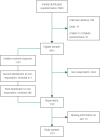Serious life events and post-traumatic stress disorder in the Norwegian population
- PMID: 31506124
- PMCID: PMC6749143
- DOI: 10.1192/bjo.2019.62
Serious life events and post-traumatic stress disorder in the Norwegian population
Abstract
Background: It has been suggested that countries with more resources and better healthcare have populations with a higher risk of post-traumatic stress disorder (PTSD). Norway is a high-income country with good public healthcare.
Aims: To examine lifetime trauma exposure and the point prevalence of PTSD in the general Norwegian population.
Method: A survey was administered to a national probability sample of 5500 adults (aged ≥18 years). Of 4961 eligible individuals, 1792 responded (36%). Responders and non-responders did not differ significantly in age, gender or urban versus rural residence. Trauma exposure was measured using the Life Events Checklist for the DSM-5. PTSD was measured with the PTSD Checklist for the DSM-5. We used the DSM-5 diagnostic guidelines to categorise participants as fulfilling the PTSD symptom criteria or not.
Results: At least one serious lifetime event was reported by 85% of men and 86% of women. The most common event categories were transportation accident and life-threatening illness or injury. The point prevalence of PTSD was 3.8% for men and 8.5% for women. The most common events causing PTSD were sexual and physical assaults, life-threatening illness or injury, and sudden violent deaths. Risk of PTSD increased proportionally with the number of event categories experienced.
Conclusions: High estimates of serious life events and correspondingly high rates of PTSD in the Norwegian population support the paradox that countries with more resources and better healthcare have higher risk of PTSD. Possible explanations are high expectations for a risk-free life and high attention to potential harmful mental health effects of serious life events.
Declaration of interest: None.
Keywords: Epidemiology; post-traumatic stress disorder; trauma.
Figures
Similar articles
-
Post-Traumatic Stress Disorder in People with Visual Impairment Compared with the General Population.Int J Environ Res Public Health. 2022 Jan 6;19(2):619. doi: 10.3390/ijerph19020619. Int J Environ Res Public Health. 2022. PMID: 35055443 Free PMC article.
-
Experience of Trauma and PTSD Symptoms in Autistic Adults: Risk of PTSD Development Following DSM-5 and Non-DSM-5 Traumatic Life Events.Autism Res. 2020 Dec;13(12):2122-2132. doi: 10.1002/aur.2306. Epub 2020 Apr 22. Autism Res. 2020. PMID: 32319731
-
Prevalence and characteristics of trauma and posttraumatic stress disorder in female prisoners in China.Compr Psychiatry. 2006 Jan-Feb;47(1):20-9. doi: 10.1016/j.comppsych.2005.04.004. Compr Psychiatry. 2006. PMID: 16324898
-
[Posttraumatic stress disorder (PTSD) as a consequence of the interaction between an individual genetic susceptibility, a traumatogenic event and a social context].Encephale. 2012 Oct;38(5):373-80. doi: 10.1016/j.encep.2011.12.003. Epub 2012 Jan 24. Encephale. 2012. PMID: 23062450 Review. French.
-
Post-traumatic Stress Disorder.Int J Occup Environ Med. 2012 Jan;3(1):2-9. Int J Occup Environ Med. 2012. PMID: 23022845 Review.
Cited by
-
Concerns Related to the COVID-19 in Adult Norwegians during the First Outbreak in 2020: A Qualitative Approach.Int J Environ Res Public Health. 2021 Apr 19;18(8):4312. doi: 10.3390/ijerph18084312. Int J Environ Res Public Health. 2021. PMID: 33921705 Free PMC article.
-
The interaction of Synapsin 2a and Synaptogyrin-3 regulates fear extinction in mice.J Clin Invest. 2024 Jan 4;134(4):e172802. doi: 10.1172/JCI172802. J Clin Invest. 2024. PMID: 38175724 Free PMC article.
-
The prevalence of potentially traumatic events in the seventh survey of the population-based Tromsø study (Tromsø 7).Scand J Public Health. 2023 Nov;51(7):1050-1060. doi: 10.1177/14034948211051511. Epub 2021 Oct 20. Scand J Public Health. 2023. PMID: 34666568 Free PMC article.
-
Gender differences in a wide range of trauma symptoms after victimization and accidental traumas: a cross-sectional study in a clinical setting.Eur J Psychotraumatol. 2021 Sep 28;12(1):1975952. doi: 10.1080/20008198.2021.1975952. eCollection 2021. Eur J Psychotraumatol. 2021. PMID: 34603637 Free PMC article.
-
Post-Traumatic Stress Disorder and Associated Factors during the Early Stage of the COVID-19 Pandemic in Norway.Int J Environ Res Public Health. 2020 Dec 9;17(24):9210. doi: 10.3390/ijerph17249210. Int J Environ Res Public Health. 2020. PMID: 33317135 Free PMC article.
References
-
- American Psychiatric Association (APA). Diagnostic and Statistical Manual of Mental Disorders (5th edn). APA, 2013.
-
- Kessler RC, Ustun TB. The WHO World Mental Health Surveys: Global Perspectives on the Epidemiology of Mental Disorders. Cambridge University Press, 2008.
-
- Dückers ML, Alisic E, Brewin CR. A vulnerability paradox in the cross-national prevalence of post-traumatic stress disorder. Br J Psychiatry 2016; 209: 300–5. - PubMed
-
- Organisation for Economic Co-operation and Development (OECD): OECD Better Life Index: Norway. OECD, 2016. (http://www.oecdbetterlifeindex.org/countries/norway/).
-
- United Nations University – Institute for Environment and Human Security (UNU-EHS), Bündnis Entwicklung Hilft. World Risk Report 2016. UNU-EHS, Bündnis Entwicklung Hilft, 2016. (http://weltrisikobericht.de/wp-content/uploads/2016/08/WorldRiskReport20...).
LinkOut - more resources
Full Text Sources
Research Materials


